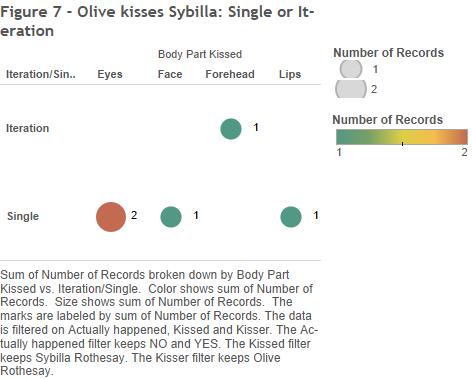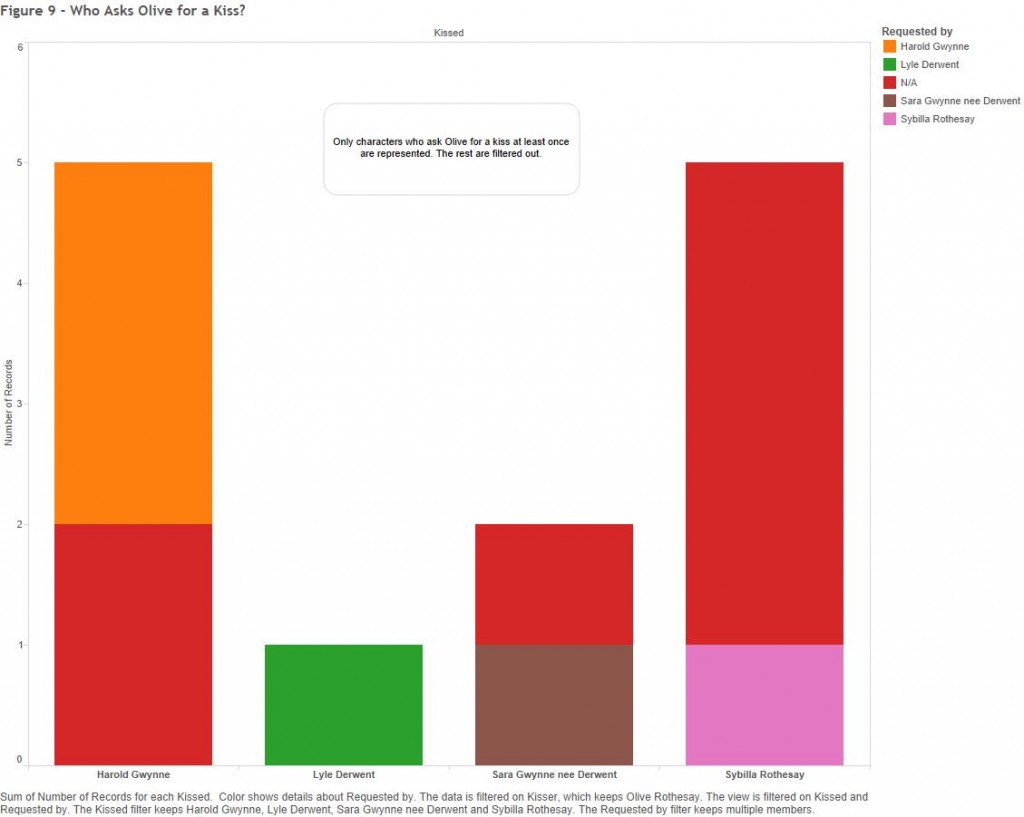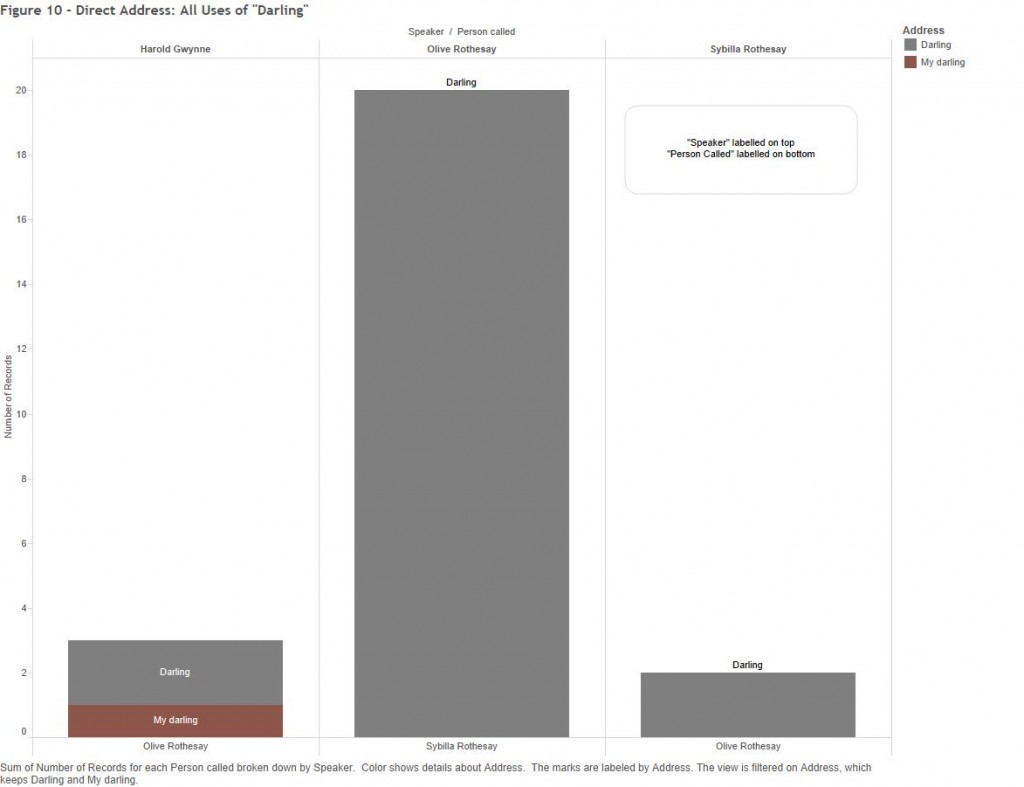Who Does Olive Actually Marry?
After doing some research, the question occurred to me: what if Olive is marrying Harold as a substitute for some other character? Sara, perhaps, given our discussion last post. To explore such a possibility, the approach used was to let the data about Olive and Harold’s shared kisses determine what qualities to examine. To explain, Olive marries Harold; the kisses between them are indicative of their courtship.[1] So to see if the kiss data could show that Harold is a substitute for someone else, it was necessary to let the details of their kisses become the “filter” for comparison. For example, Figure 1 shows which of Harold’s body parts Olive kissed: eyes, forehead and lips.
Thus, I set the “body part kissed” filter to just show the data for those three parts when Olive was the kisser, and I opened the “kissed” filter to include “All”. The data on kisses between Olive and Harold became the lens through which all Olive’s other relationships were viewed. Therefore, all characters had a shot, regardless of my preconceptions. Though Sara seemed a good possibility at first, in total the data provides stronger evidence that Olive actually marries both her parents in the guise of Harold, with the case for Olive’s mother being somewhat more solid than the one for Angus.
Unlike the last post, this question is not based on a close reading of Olive. Rather, the question was raised upon reading the sociological paper “Cousin Marriage in Victorian England” by Nancy Anderson. Anderson argues that because of the limits placed on “extra-familial heterosexual social contacts” in the Victorian age, romantic or sexual longing was largely focused on “incestuous feelings” for parents and/or siblings (286). Marrying a cousin, Anderson writes, was often a socially accepted manner of realizing the bond between “nuclear family members”, making the cousin a sexual substitute for one’s taboo desire for sibling or parent (286, 287, 289, 290, 291). Such a conception fits for Olive and Harold as they are technically relatives linked through Aunt Flora, though the relation is at least partly by marriage and not by blood. Therefore, Olive’s family members joined Sara as candidates for who Olive actually marries.
After reading Anderson’s paper, I hypothesized two options for such “incestuous” desire: Angus and Sibylla. Olive’s deceased infant brother (chap 7)[2] was quickly rejected, simply because with only one kiss to look at, the data was almost useless (chap 7). Christal, though she is Olive’s sister, was also raised as a possibility, but she seemed problematic as Olive only learned Christal was her sister (chap 41) after she started loving Harold (chap 35). Even though I had my theories, the data was left open so it could show me otherwise.
Before looking at the parents, one should note that two other extra-familial options were also considered quite strong, before ever looking at the data: Harold as a substitute for Sara, and Harold loved for-his-own-sake. The queer and sisterly aspects of Sara and Olive’s relationship were touched on last time, hence her candidacy. That Sara was also Harold’s first wife, helped her case (Bourrier ENG 607 class notes). However, Sara’s kisses with Olive show little similarity[3] to Harold’s kisses with Olive, at least not any similarities that other characters could not be said to share too. With regards to the idea of Harold not being a substitute for anyone, hypothetically, if no kiss-similarities showed up, that might not prove that Olive loves Harold for his own sake; though it would definitively remove the kiss data as a support for a love-substitution theory.
Likewise, the kiss data itself does not prove that Olive marries an Angus and Sybilla substitute named Harold; though it does offer compelling evidence in support of such a hypothesis. Beginning with the weaker case, that for Angus, Figures 2 and 3 help show two limited similarities the father-daughter kisses have with those of the courting couple.
Figure 2 shows that of all the characters to kiss Olive only Harold and Angus kiss her hair.[4] Additionally, these are the only two hair-kisses in the whole novel (fig 4). Problematically, the rest of the kisses from these men to Olive lack any similarity, though that perhaps does not rob the power of the fact that these two pairings are the only two to engage in this kiss type.
Figure 3, comparing the “reason for/quality of” kisses shows another, less convincing, similarity. Comparing Harold to Angus here requires a recognition of the limits inherent to the “reason for/quality of” kisses (see first post). A close reading of Angus’s “comforting”, “long-distance” and “parting” kisses could show if they are also “free/loving”. A cursory reading of the quotations for these seems to support that notion, as does the fact (fig 5) that these five kisses were unasked for. Harold, too, kisses Olive five times unasked (fig 5). So there is some tenuous kiss-based evidence, requiring further support, that the love Olive receives from Harold is similar to that which she receives from her father.
Figures 2 and 3 also reveal that the kisses from Harold to Olive are nothing like the ones from Sybilla to her daughter; however, when Olive is the kisser, the picture changes dramatically, allowing one to use the kiss-data as a basis for a Harold-as-substitute-mother interpretation. Figure 6 takes the data from Figure 1 above – showing which of Harold’s body parts Olive kisses – and expands it to all the people Olive kisses. Two things become immediately clear. First, Olive seems to kiss both Harold and Sybilla the same amount of times. Second, the breakdown of body parts kissed is nearly identical: eyes, forehead and lips, all in almost the same amount.
As I do not wish to change the data to fit my established concepts (Heuser and Le-Khac 81), I will avoid equating face and forehead, though a case could be made based on the quote that covers both kisses.[5] Unfortunately, there is a potential error in this graph (fig 6), as Olive’s single kiss to her mother’s forehead does not “actually happen” in the novel’s narrative (Actually happened? = NO). However, there is a strong reason for including it from the data itself; though the instance does not occur, it is an iteration (see first post) (fig 7).
The quote itself – “it must come—she would kiss her mother’s brow for the last time” – shows the iterative quality; Olive must have kissed her mother on the forehead at least once, in order to do it one final time. Though the “body parts kissed” connection is the strongest, some few other weaker similarities show up between Harold and Sybilla as well. If one sees Olive’s “healing” and “death” kisses to her mother as akin to “comforting”,[6] then Olive kisses both her mother and future husband for similar reasons, though not in the same amounts (fig 8). Likewise, both Sybilla and Harold sometimes ask for Olive’s kisses and sometimes get them without asking (fig 9).
However, if that did not seem convincing for Sara’s case, why should it here? So, other than the strong correlation between the total number of kisses Olive gives to Harold and Sybilla, and the convincing similarity in body parts kissed, the data does not do much for the theory that Olive marries Harold as a substitute for her mother.
Still those two similarities are quite striking, offering a least some evidence towards the hypothesis; perhaps further distant- and close-reading evidence could supplement what the kiss data alone cannot provide. Distant wise (fig 10), only three people in the novel call another “darling” in direct conversation with that person: Olive calls Sybilla “darling”, and both Harold and Sybilla call Olive likewise.[7] Additionally Harold and Sybilla do so about the same amount.
The word “darling” could be an important mother-daughter relationship indicator, [8] as Olive says it protectively toward her mother, thus potentially making Harold’s inclusion significant. Close reading could help determine this possibility. Close reading does reveal that Harold replaces Sybilla in Olive’s heart within chapters of Sybilla’s death. Sybilla dies in Chapter 32; the next three chapters largely focus on Olive’s growing feelings for Harold (despite a religious interlude), culminating in her admission to herself that she loves him (chap 35). The kissing data is not the sole pointer to Harold being a substitute-Sybilla.
The kiss data opens the possibility that Harold is a cousin substitute for Olive’s love for her mother, perhaps with some elements of his affection resembling her father’s. More work, both distantly and closely with the text is required to make a strong interpretation in that direction; especially if, following Anderson, one wishes to look at the potential sexual element. The first seeds of this particular Olive tree are there for the planting; and they are there in kisses.
Endnotes
[1] Olive and Harold never kiss in the final chapter, the only chapter in which they are married. Perhaps this fact warrants a paper of its own.
[2] All citations from Olive are from the 1875 edition of the novel, as found on the Project Gutenberg website, as this was the text I used for the collection of the data. Unfortunately, that means there are no page numbers, thus chapters are cited.
[3] There are a few commonalities, such as: both Harold and Sara ask Olive for kisses some of the time (see Fig 9 below).
[4] Though Angus only kisses a lock of her hair sent to him in Jamaica.
[5] The quote for both face and forehead is: “To chase it thence, she stooped and softly kissed the face which to her was, and ever had been, the most beautiful in the world; and then, following the train of her former musings, came the thought that one day—it might be far distant, but still, in all human probability, it must come—she would kiss her mother’s brow for the last time” (chap 26). Therefore, arguably the feared future “brow” kiss is strongly linked with the “face” kiss; perhaps making them the same body part.
[6] Again, like the Angus argument this requires close reading or other evidence to justify.
[7] This data comes from my counting of the approximately 950 direct addresses in Olive – with “Direct Address” simply meaning what Person A calls Person B when, and only when, talking to Person B. What person A calls Person B when talking to Person C is not counted. The data was collected with strict rules, most similar to the kissing data, or analogous to it. There is not enough space here to get into all the details.
[8] “Darling” is one of two appellations that the narrator described directly: “Olive often said “darling” quite in a protecting way” (chap 19). The other is a cold “my dear” (chap 10).
Works Cited
Anderson, Nancy Fix. “Cousin Marriage in Victorian England.” Journal of Family History 11.3 (1986): 285-301. Web. 21 Mar. 2015.
Bourrier, Karen. ENG 607 L01. University of Calgary. Winter 2015. Class discussion notes.
Heuser, Ryan, and Long Le-Khac. “Learning to Read Data: Bringing out the Humanistic in the Digital Humanities.” Victorian Studies 54.1 (2011): 79-86. JSTOR. Web. 22 Mar. 2015.

The Kisses of Dinah Mulock Craik’s Olive by Aaron Ellsworth is licensed under a Creative Commons Attribution-NonCommercial-ShareAlike 4.0 International License.

![Figure 2 - Where People Kiss Olive [Compared to Harold]](http://aaronellsworth.ca/wp-content/uploads/2015/04/C-Figure-2-Where-People-Kiss-Olive-Compared-to-Harold.jpg)
![Figure 3 - Harold and Others Kiss Olive [QualityReason]](http://aaronellsworth.ca/wp-content/uploads/2015/04/C-Figure-3-Harold-and-Others-Kiss-Olive-QualityReason.jpg)


![Figure 6 - Where Olive Kisses People [Compared to Harold]](http://aaronellsworth.ca/wp-content/uploads/2015/04/C-Figure-6-Where-Olive-Kisses-People-Compared-to-Harold.jpg)

![Figure 8 - Olive Kisses Harold and Others [Reason for/Quality of]](http://aaronellsworth.ca/wp-content/uploads/2015/04/C-Figure-8-Olive-Kisses-Harold-and-Others-Reason-forQuality-of.jpg)

